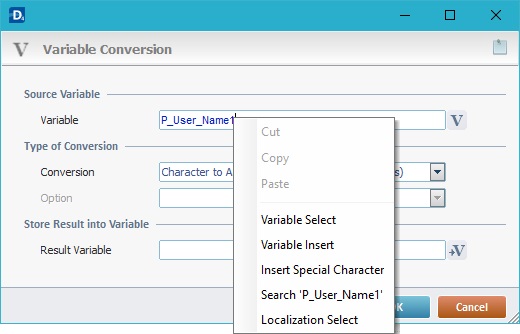Working with Write Process
Process Purpose
The "RFID Write" process is used in a “single tag” operation (synchronous operation) to write information into the fields of a tag's memory bank. This process may not be available for all RFID tag types, meaning, not all RFID tags are writable.
![]() When writing more than 64 bytes in the User Memory Bank (for instance, the complete memory bank), the system will write the data in blocks of 64 bytes (RFID reader will flash multiple times).
When writing more than 64 bytes in the User Memory Bank (for instance, the complete memory bank), the system will write the data in blocks of 64 bytes (RFID reader will flash multiple times).
![]() When using this process, you must take the current state of the targeted RFID tag(s) into account - the tags must be unlocked when executing this process. If they are locked, make sure the RFID profile you apply includes the corresponding "access password" so the data can be written successfully.
When using this process, you must take the current state of the targeted RFID tag(s) into account - the tags must be unlocked when executing this process. If they are locked, make sure the RFID profile you apply includes the corresponding "access password" so the data can be written successfully.
![]()
Make sure you have already created the required RFID profile(s). See Creating an RFID Profile.
Check the necessary steps to create an RFID program in To Create an RFID Program.
![]() The "RFID Write" process MUST NOT be associated to an "RFID" action.
The "RFID Write" process MUST NOT be associated to an "RFID" action.
When you add a process, you are required to define its settings. This occurs in the process's properties window which is displayed automatically after having added the "RFID Write" process.
If any subsequent edition is required, double-click the process to open its properties window and enter the necessary modifications.

Fill in the following options:
RFID Settings |
|
Profile |
Select the appropriate RFID profile from the drop-down. If required, click |
Tag ID |
Define the tag to be written. Either enter the tag's ID OR click
If this process is meant to be executed after an “RFID Read” process and you want to use a variable to identify the tag, we suggest selecting the default Local variable “L_Tag_ID” (this variable stores the tag's EPC).
Do NOT use the tag’s TID information to define the tag to be written within this process.
|
Fields to Write |
|
Write into Field column |
Define the tag field to have data written on it. Select the appropriate field from the drop-down. |
Value/Variable column |
Define the value to be written in the selected tag field. Either enter it OR click |
If Error |
|
Go to |
Select a target destination, in case an error occurs, from the drop-down or
|
Detail of a ![]() window:
window:

"S:Menu" is a screen included in the same program as the process.
"R:Routine_1" is a routine included in the same program as the process.
Use the editing icons to the right of the table to move the rows up and down and to delete or add more rows.
If required, click ![]() to attach any relevant notes to this process. Click it and enter your notes in the resulting text box. These notes will be displayed in the corresponding "Actions" tab or "Process" window (in the "Notes" field) and in the "Developer Report".
to attach any relevant notes to this process. Click it and enter your notes in the resulting text box. These notes will be displayed in the corresponding "Actions" tab or "Process" window (in the "Notes" field) and in the "Developer Report".
After filling in the required options, click ![]() to conclude or
to conclude or ![]() to abort the operation.
to abort the operation.
The added process is displayed in the corresponding "Actions" tab or "Process" window.
![]() If you want to use a label as a target destination, you can use the "Auto-Label" mechanism. This alternative to the "Set Label" process allows you to create a label in the properties window of a process - specifically, in the fields used to define target destinations (ex: the "If Error..." type fields). See To Automatically Create a Label.
If you want to use a label as a target destination, you can use the "Auto-Label" mechanism. This alternative to the "Set Label" process allows you to create a label in the properties window of a process - specifically, in the fields used to define target destinations (ex: the "If Error..." type fields). See To Automatically Create a Label.
![]()
Use the right-click in MCL-Designer's input boxes to access some related options as well as the general "Cut", "Copy"; "Paste"; "Search" actions (active/inactive according to the current context).
Ex: If you right-click the "Variable" input box (included in a "Conversion's" properties window), you are provided with general editing/search actions and other more specific options such as "Variable Select" (see "Variable Select"); "Variable Insert" (see "Variable Insert"); "Insert Special Character" (see To Insert Special Characters into a Control's Text Input Field) and "Localization Select" (see Localization List).
If you right-click another input box, it may provide other possibilities.
